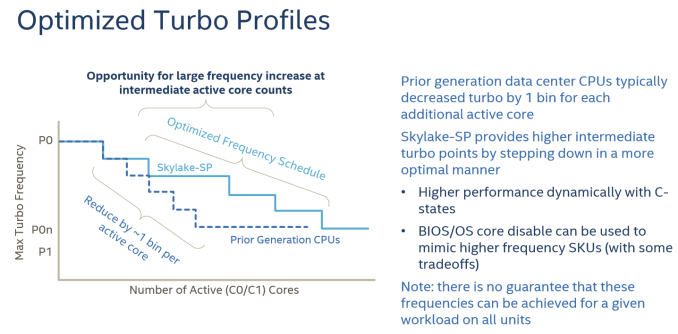Sizing Up Servers: Intel's Skylake-SP Xeon versus AMD's EPYC 7000 - The Server CPU Battle of the Decade?
by Johan De Gelas & Ian Cutress on July 11, 2017 12:15 PM EST- Posted in
- CPUs
- AMD
- Intel
- Xeon
- Enterprise
- Skylake
- Zen
- Naples
- Skylake-SP
- EPYC
Intel's Optimized Turbo Profiles
Also new to Skylake-SP, Intel has also further enhanced turbo boosting.
There are also some security and virtualization enhancements (MBE, PPK, MPX) , but these are beyond the scope this article as we don't test them.
Summing It All Up: How Skylake-SP and Zen Compare
The table below shows you the differences in a nutshell.
| AMD EPYC 7000 |
Intel Skylake-SP | Intel Broadwell-EP |
|
| Package & Dies | Four dies in one MCM | Monolithic | Monolithic |
| Die size | 4x 195 mm² | 677 mm² | 456 mm² |
| On-Chip Topology | Infinity Fabric (1-Hop Max) |
Mesh | Dual Ring |
| Socket configuration | 1-2S | 1-8S ("Platinum") | 1-2S |
| Interconnect (Max.) Bandwidth (*)(Max.) |
4x16 (64) PCIe lanes 4x 37.9 GB/s |
3x UPI 20 lanes 3x 41.6 GB/s |
2x QPI 20 lanes 2x 38.4 GB/s |
| TDP | 120-180W | 70-205W | 55-145W |
| 8-32 | 4-28 | 4-22 | |
| LLC (max.) | 64MB (8x8 MB) | 38.5 MB | 55 MB |
| Max. Memory | 2 TB | 1.5 TB | 1.5 TB |
| Memory subsystem Fastest sup. DRAM |
8 channels DDR4-2666 |
6 channels DDR4-2666 |
4 channels DDR4-2400 |
| PCIe Per CPU in a 2P |
64 PCIe (available) | 48 PCIe 3.0 | 40 PCIe 3.0 |
(*) total bandwidth (bidirectional)
At a high level, I would argue that Intel has the most advanced multi-core topology, as they're capable of integrating up to 28 cores in a mesh. The mesh topology will allow Intel to add more cores in future generations while scaling consistently in most applications. The last level cache has a decent latency and can accommodate applications with a massive memory footprint. The latency difference between accessing a local L3-cache chunk and one further away is negligible on average, allowing the L3-cache to be a central storage for fast data synchronization between the L2-caches. However, the highest performing Xeons are huge, and thus expensive to manufacture.
AMD's MCM approach is much cheaper to manufacture. Peak memory bandwidth and capacity is quite a bit higher with 4 dies and 2 memory channels per die. However, there is no central last level cache that can perform low latency data coordination between the L2-caches of the different cores (except inside one CCX). The eight 8 MB L3-caches acts like - relatively low latency - spill over caches for the 32 L2-caches on one chip.

















219 Comments
View All Comments
Kaotika - Tuesday, July 11, 2017 - link
http://www.anandtech.com/show/11464/intel-announce...This one remains wrong though
Ian Cutress - Tuesday, July 11, 2017 - link
Always reference the newest piece, especially the main review.Or we'd spend half of our time going back and updating old pieces and reviews with new data.
scottb9239 - Tuesday, July 11, 2017 - link
On the POV-RAY benchmark, shouldn't that read as almost 16% faster than the dual 2699 v4 and 32% faster than the dual 8176?scienceomatica - Tuesday, July 11, 2017 - link
I think that a fair game would be to compare the top offer of one and the other manufacturer, in other words, the Xeon 8180 should be included in the benchmark regardless of the aspect of the price. Then the difference would be quite in favor of the Intel processor, although it has few cores less.Tamz_msc - Tuesday, July 11, 2017 - link
Will we get to see more FP HPC-oriented workloads like SPECfp2006 or even 2017 being discussed in a future article?lefty2 - Tuesday, July 11, 2017 - link
I can summarize this article: "$8719 chip beaten by $4200 chip in everything except database and Appache spark."Well done Intel, another Walletripper!
Shankar1962 - Wednesday, July 12, 2017 - link
Then why did google att aws etc upgraded to skylake. They could have saved billions of dollars.Shankar1962 - Wednesday, July 12, 2017 - link
Look at what big players upgrading to skylake reportedThese are real workloads
No one cares about labs
These numbers decide who wins and who loses
No wonder AMD sells at $4200
https://www.google.com/amp/s/seekingalpha.com/amp/...
nitrobg - Tuesday, July 11, 2017 - link
Pricing on page 10 should reflect that the 2P EPYC prices are for 2 processors, not per CPU. The price of Xeons is per CPU.coder543 - Tuesday, July 11, 2017 - link
That doesn't seem true. The prices they currently have seem to be correct. Got a source?